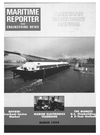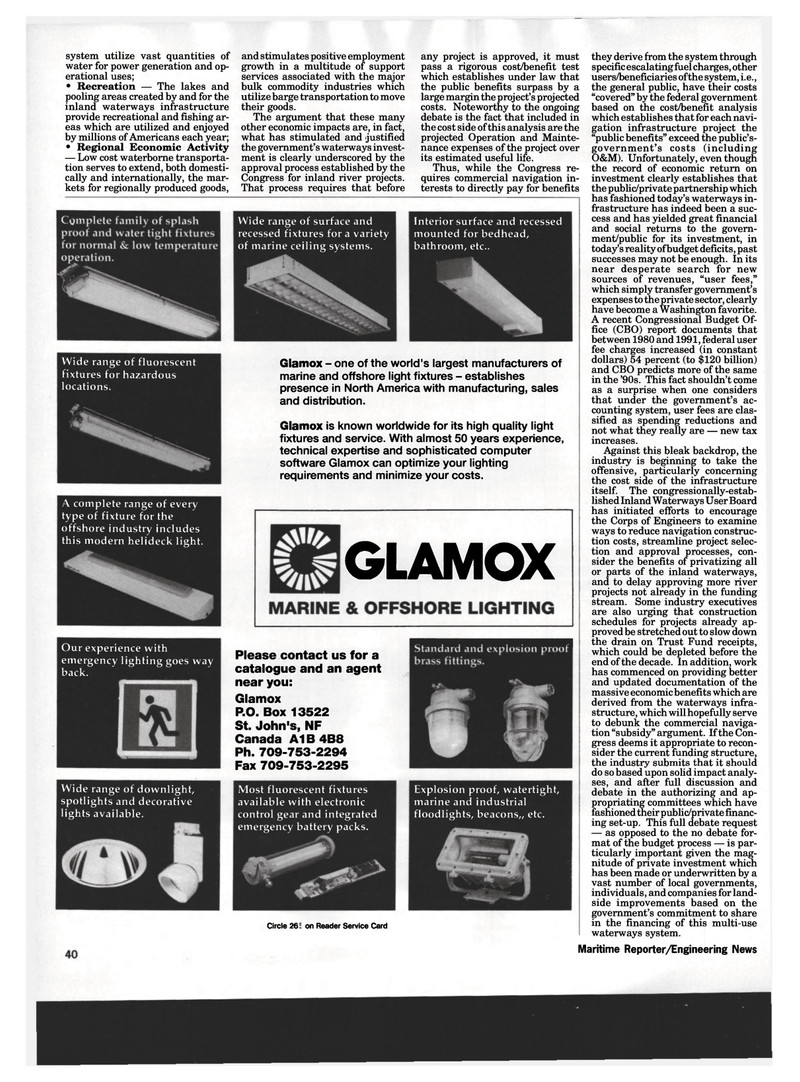
Page 38: of Maritime Reporter Magazine (March 1994)
Read this page in Pdf, Flash or Html5 edition of March 1994 Maritime Reporter Magazine
system utilize vast quantities of water for power generation and op- erational uses; • Recreation — The lakes and pooling areas created by and for the inland waterways infrastructure provide recreational and fishing ar- eas which are utilized and enjoyed by millions of Americans each year; • Regional Economic Activity — Low cost waterborne transporta- tion serves to extend, both domesti- cally and internationally, the mar- kets for regionally produced goods, and stimulates positive employment growth in a multitude of support services associated with the major bulk commodity industries which utilize barge transportation to move their goods.
The argument that these many other economic impacts are, in fact, what has stimulated and justified the government's waterways invest- ment is clearly underscored by the approval process established by the
Congress for inland river projects.
That process requires that before any project is approved, it must pass a rigorous cost/benefit test which establishes under law that the public benefits surpass by a large margin the project's projected costs. Noteworthy to the ongoing debate is the fact that included in the cost side of this analysis are the projected Operation and Mainte- nance expenses of the project over its estimated useful life.
Thus, while the Congress re- quires commercial navigation in- terests to directly pay for benefits
Wide range of fluorescent fixtures for hazardous locations.
A complete range of every type of fixture for the offshore industry includes this modern helideck light.
Our experience with emergency lighting goes way back.
Wide range of downlight, spotlights and decorative lights available.
Wide range of surface and recessed fixtures for a variety of marine ceiling systems.
Interior surface and recessed mounted for bedhead, bathroom, etc..
Glamox - one of the world's largest manufacturers of marine and offshore light fixtures - establishes presence in North America with manufacturing, sales and distribution.
Glamox is known worldwide for its high quality light fixtures and service. With almost 50 years experience, technical expertise and sophisticated computer software Glamox can optimize your lighting requirements and minimize your costs.
GLAMOX
Please contact us for a catalogue and an agent near you:
Glamox
P.O. Box 13522
St. John's, NF
Canada A1B 4B8
Ph. 709-753-2294
Fax 709-753-2295
Most fluorescent fixtures available with electronic control gear and integrated emergency battery packs.
Explosion proof, watertight, marine and industrial floodlights, beacons,, etc.
Circle 268 on Reader Service Card they derive from the system through specific escalating fuel charges, other users/beneficiaries of the system, i.e., the general public, have their costs "covered" by the federal government based on the cost/benefit analysis which establishes that for each navi- gation infrastructure project the "public benefits" exceed the public's- government's costs (including
O&M). Unfortunately, even though the record of economic return on investment clearly establishes that the public/private partnership which has fashioned today's waterways in- frastructure has indeed been a suc- cess and has yielded great financial and social returns to the govern- ment/public for its investment, in today's reality of budget deficits, past successes may not be enough. In its near desperate search for new sources of revenues, "user fees," which simply transfer government's expenses to the private sector, clearly have become a Washington favorite.
A recent Congressional Budget Of- fice (CBO) report documents that between 1980 and 1991, federal user fee charges increased (in constant dollars) 54 percent (to $120 billion) and CBO predicts more of the same in the '90s. This fact shouldn't come as a surprise when one considers that under the government's ac- counting system, user fees are clas- sified as spending reductions and not what they really are — new tax increases.
Against this bleak backdrop, the industry is beginning to take the offensive, particularly concerning the cost side of the infrastructure itself. The congressionally-estab- lished Inland Waterways User Board has initiated efforts to encourage the Corps of Engineers to examine ways to reduce navigation construc- tion costs, streamline project selec- tion and approval processes, con- sider the benefits of privatizing all or parts of the inland waterways, and to delay approving more river projects not already in the funding stream. Some industry executives are also urging that construction schedules for projects already ap- proved be stretched out to slow down the drain on Trust Fund receipts, which could be depleted before the end of the decade. In addition, work has commenced on providing better and updated documentation of the massive economic benefits which are derived from the waterways infra- structure, which will hopefully serve to debunk the commercial naviga- tion "subsidy" argument. If the Con- gress deems it appropriate to recon- sider the current funding structure, the industry submits that it should do so based upon solid impact analy- ses, and after full discussion and debate in the authorizing and ap- propriating committees which have fashioned their public/private financ- ing set-up. This full debate request — as opposed to the no debate for- mat of the budget process — is par- ticularly important given the mag- nitude of private investment which has been made or underwritten by a vast number of local governments, individuals, and companies for land- side improvements based on the government's commitment to share in the financing of this multi-use waterways system. 40 Maritime Reporter/Engineering News

 37
37

 39
39
